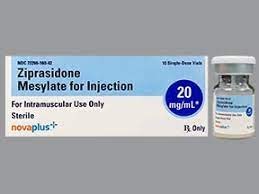A nurse is preparing to administer ziprasidone 10 mg IM every 6 hr. Available is ziprasidone 20 mg/mL. How many mL should the nurse administer per dose? (Round the answer to the nearest tenth. Use a leading zero if it applies. Do not use a trailing zero.)
The Correct Answer is ["0.5"]
To calculate the amount of ziprasidone 10 mg IM from the available concentration of 20 mg/mL, you can use the formula:
Amount (mL) = Desired Dose (mg) / Concentration (mg/mL)
Amount (mL) = 10 mg / 20 mg/mL
Amount (Ml) = 0.5 mL
Therefore, the nurse should administer 0.5 mL of ziprasidone per dose.

Nursing Test Bank
Naxlex Comprehensive Predictor Exams
Related Questions
Correct Answer is ["7"]
Explanation
To calculate the volume (mL) of amoxicillin needed, you can use the following formula:
Volume (mL) = Dose (mg) / Concentration (mg/mL)
Given that the dose is 350 mg and the concentration is 250 mg/5 mL:
Volume (mL) = 350 mg / 250 mg/5 mL
First, calculate the concentration of amoxicillin in mg/mL:
250 mg / 5 mL = 50 mg/mL
Now, use the calculated concentration to find the volume:
Volume (mL) = 350 mg / 50 mg/mL = 7 mL
So, the nurse should administer 7 mL of amoxicillin.
Correct Answer is D
Explanation
A) Maturational crisis:
This type of crisis arises from normal life transitions, such as entering a new stage of development (adolescence, midlife crisis, etc.). It involves a struggle to adapt to new roles and responsibilities. The client's situation does involve a life transition due to the death of his wife, but the sudden nature of the event and the resulting distress suggest a situational crisis.
B) Adventitious crisis:
Adventitious crises are caused by extraordinary events that are external to the individual's usual experience, such as natural disasters, accidents, or crimes. While the sudden death of the client's wife is an unexpected and tragic event, it's not an adventitious crisis because it involves personal loss rather than a large-scale or external event.
C) Developmental crisis:
Developmental crises are associated with specific stages of life and the challenges and changes that come with them. This crisis doesn't seem to fit the developmental category as it is more tied to the specific event of the wife's sudden death.
D) Situational crisis
Explanation:
A situational crisis is a type of crisis that arises from a specific event or situation that disrupts an individual's normal functioning and coping abilities. In this case, the sudden death of the client's wife is the triggering event that has led to his feeling paralyzed and overwhelmed in his ability to cope with work and family responsibilities. Situational crises are often unexpected and can lead to a temporary state of disorganization and distress.
Whether you are a student looking to ace your exams or a practicing nurse seeking to enhance your expertise , our nursing education contents will empower you with the confidence and competence to make a difference in the lives of patients and become a respected leader in the healthcare field.
Visit Naxlex, invest in your future and unlock endless possibilities with our unparalleled nursing education contents today
Report Wrong Answer on the Current Question
Do you disagree with the answer? If yes, what is your expected answer? Explain.
Kindly be descriptive with the issue you are facing.
